In our first instalment on outriggers last month, we covered the reasoning behind why you might use outriggers on your boat (one outrigger on each side of the boat). Also we covered the basics of rigging them ‘one-up’ with a single pin-type release clip on each rigger.
In this edition we will look at rigging each outrigger with multiple release clips so that you can troll two or even three lines per outrigger. As a variation, we will also cover rigging outriggers with alternative release clips (e.g. both ‘peg’ and ‘pin’ styles of release clips).
If you want to run more than one line from each rigger you can either run two clips on the one rigger halyard or you can run two halyards with their own releases.
In my opinion, having two release clips on the same halyard makes it hard to fine tune the placement of each of your fishing lines. Also, the pressure of two lines connected to the same halyard sometimes compounds the problem of what I call ‘halyard creep’. Halyard creep is the pressure on the rigger halyard that pulls it in ever so slightly and causes the clips to creep down, which reduces the tension in the fishing lines which can then allow tangles. The heavier bait or lure, i.e. the one creating the most drag, will take some tension off the other release clip. This then allows the other clip to twist or flip and tangle.
To avoid this, most crews running multiple clips will run each clip off a separate individual halyard in order to troll two or more baits off each outrigger.
Running each clip off an individual halyard also permits precise positioning adjustments for each release clip and therefore for each fishing line that is being trolled via a clip.
As covered last month, the basic rigging set-up has a mono-line type halyard that threads through a series of eyelets attached along the rigger pole, and the base end consists of a glass ring on shock cord.
When running two halyards, the longer one runs to the highest eyelet on the rigger (just like a single halyard rig) and the shorter one terminates at one of the eyes in the outrigger between halfway and two thirds up the pole.
At the base\boat end of the multiple halyard set-up you have a couple of options, mainly glass rings or pulleys. The photos accompanying this article will tell the story.
There pros and cons of using pulleys over glass rings. Although glass rings can shatter, they do offer enough friction between halyard and ring that the halyard is usually held in place. Unlocked pulleys allow halyard creep (the release clip vibrates down) unless you use Hal Locks or clip the two sides of each halyard together to stop them moving. You can use a flat line clip, like a giant clothes peg, to keep the halyard from creeping. Hal Locks are a roller pulley system with the ability to lock the line\halyard in place with the flip of a switch.
Now let’s look at the photos.
In future editions we will cover tag lines for trolling lures and also centre riggers. In the meantime, here’s some basic info.
A tag line runs back behind the outrigger pole tip, roughly the length of the pole to reduce angle and minimise the length of line from rod tip to lure. The main line from the rod tip attaches to the tag line end with an elastic band and the band breaks when a fish grabs the lure. It's fairly simple and very effective.
The problem with running a tag line from each outrigger is that they are hard to reach, and this is where line weights or tag line slides come into play. A slide is a metal barrel with a hole though the centre. Tag line slides come in chromed brass or stainless steel and are about 50-60mm long and around 25mm in diameter. They go over the outrigger line that runs from the boat to the pole tip and the tag line. When a lure is run out, the pull on the tag line drags the slide out to the end of the pole so the line stays out there where it should be. When a fish grabs the lure and breaks the elastic band connecting the tag line to the main line, the weight of the slide brings the tag line back down to within reach.
More on this next month. Stay tuned!
Reads: 10588
Outriggers in the stowed position showing the two individual lanyards running up to different height eyelets on the rigger poles. Running them to different height eyelets keeps the two halyards separate and creates angles that also keep the clips far enou
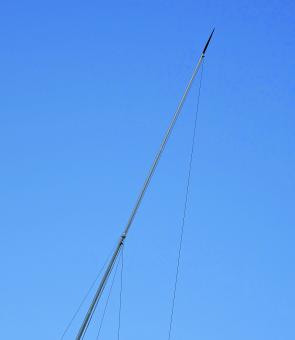
A close-up of one of the rigger poles showing the two separate halyards.

In single or multiple riggings the shock cord (aka bungee cord) is run to either a pad eye or a jam cleat.
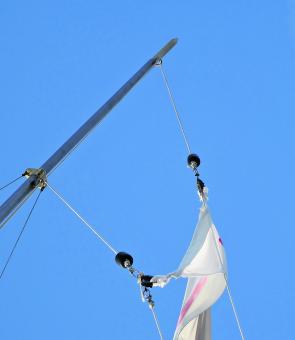
This image provides a good view of an outrigger tip running two clips on independent halyards (however the attempt to run one flag using both clips is probably a fail!) It demonstrates that you don’t normally want to run both clips so close together,
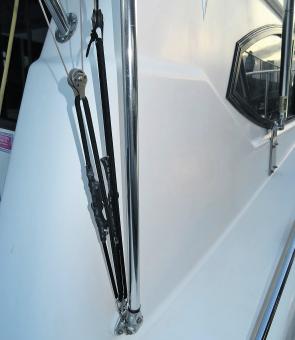
This is one way to run two base terminations. This is a version of the double shock cord system for the boat’s base end termination.

This is the in-line double pulley system for the boat end termination. The outrigger release in this photo is the flat peg type, used with heavy tackle slow trolling when you don’t want the fishing line to be movable through a rigger pin. Some crews run d

A Rupp Release Clip incorporated into a double line system. Some anglers and crews prefer this style of clip for heavier line classes.
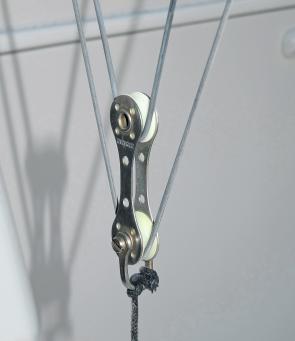
Another double pulley inline option, this time in close up.
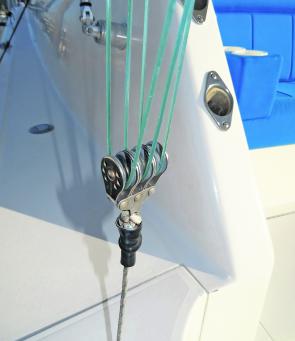
A triple side-by-side system.
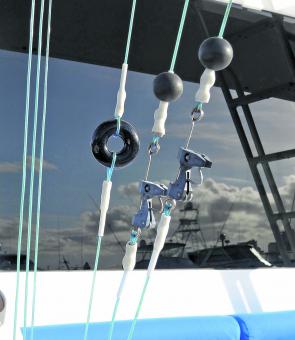
A triple attachment system (most crews find running two release clips to be more than enough). The third attachment may be used for a teaser or tag line or simply somewhere to tie off a flag/pendant.




